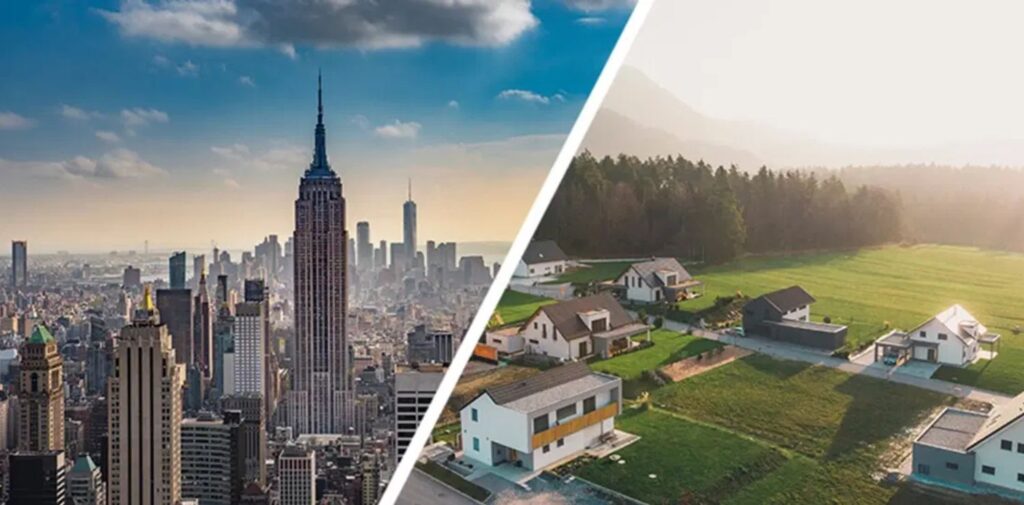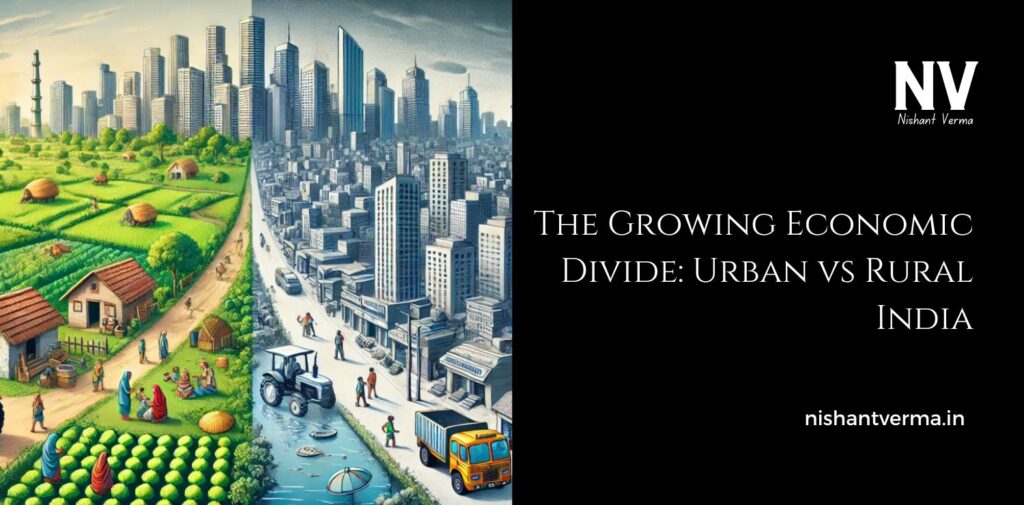India, one of the fastest-growing economies in the world, has made incredible progress in various sectors over the years. But there is one issue that continues to grow – the economic divide between urban and rural areas. The difference in lifestyle, income, and opportunities between people living in cities and those in villages has been widening for decades. This divide has become one of the biggest challenges in India’s development.

What is the Economic Divide?
The economic divide refers to the difference in wealth, income, education, and opportunities between urban (city) and rural (village) areas. Cities like Delhi, Mumbai, and Bengaluru are home to fast-growing industries, big companies, modern infrastructure, and advanced technology. In contrast, rural areas still rely on farming, lack good healthcare, education, and proper infrastructure.
Urban India: The Growing Cities
India’s cities have seen a lot of growth. Cities are places where businesses thrive, industries run, and people from different parts of the country come looking for better opportunities. With new roads, advanced schools, hospitals, and technology, life in the cities can seem very comfortable.
In cities, there are many job opportunities. People work in offices, hospitals, schools, shops, and factories. Many people in the cities work in high-paying jobs, while others are involved in small businesses or trade. Cities also offer better healthcare and education, making life easier for those who live there.
However, cities also have their problems. There is overcrowding, high pollution, and expensive living costs. Still, urban areas have better opportunities for people to improve their lives.
Rural India: The Heart of India
Rural India, which is spread across thousands of villages, is where most of India’s population lives. Agriculture is the backbone of rural India. People here grow crops like rice, wheat, sugarcane, and vegetables. They also rely on livestock for their income. But the lives of people living in villages are very different from those in cities.
In rural areas, basic services like electricity, water, healthcare, and education are often unavailable or not of good quality. Many rural families live in poverty and struggle to make ends meet. The income levels are much lower compared to urban areas, and people depend on farming for their livelihoods.
Even though agriculture is important, it often does not earn enough money to support a comfortable life. Farmers face many challenges such as poor soil, limited water, unpredictable weather, and a lack of access to modern farming equipment. Because of this, many people in rural areas continue to live below the poverty line.

The Growing Gap Between Urban and Rural Areas
Over time, the gap between urban and rural areas has continued to grow. Cities are getting richer, with more job opportunities, modern services, and better infrastructure. On the other hand, rural areas are still struggling with poverty, lack of basic services, and limited opportunities.
1. Education and Healthcare
One of the biggest differences between urban and rural areas is access to education and healthcare. In cities, people have easy access to schools, colleges, hospitals, and clinics. These institutions are well-equipped, with qualified teachers, doctors, and good facilities. People in cities often live longer and healthier lives due to better healthcare and medical treatments.
In rural areas, many villages do not have proper schools or hospitals. Children may have to travel long distances to attend school, and some may not even complete their education. The healthcare facilities are basic, and many villagers rely on local healers or traditional medicine. Lack of proper healthcare leads to high rates of illness and even deaths from diseases that can be easily treated.
2. Employment and Income
In cities, there are many jobs available in various fields such as IT, business, marketing, engineering, and healthcare. People can earn more money and improve their living standards. As industries grow, more people find jobs that pay well.
In contrast, rural areas are mainly dependent on agriculture. While farming is important, it does not provide enough money for many people to live comfortably. There are fewer job opportunities in rural areas, and many young people from villages migrate to cities in search of work. This migration leads to a shortage of workers in rural areas, making farming even harder.
3. Infrastructure and Technology
Urban areas are known for their modern infrastructure, including good roads, public transportation, reliable electricity, and high-speed internet. People in cities have access to the latest technology and modern facilities. These advances make life easier and allow people to connect with the world.
On the other hand, rural areas often lack basic infrastructure. Many villages still do not have proper roads, and electricity supply is irregular. Access to the internet is limited, making it difficult for people to access information, learn new skills, or connect with others. The lack of infrastructure in rural areas keeps people from growing and developing at the same rate as people in cities.
Why Is the Economic Divide Growing?
Several factors have contributed to the growing gap between urban and rural areas in India.
1. Lack of Focus on Rural Development
For many years, most of India’s development has focused on cities. Governments and businesses have put more money and effort into urban areas because they are seen as more economically productive. This has led to the growth of cities and the neglect of rural areas. As a result, rural areas continue to lag behind in terms of development.
2. Migration to Cities
Many young people from rural areas move to cities for better job opportunities. This migration has led to an increase in the population of cities, while the rural areas have fewer people working in farming. This shift has worsened the economic divide because cities become richer, while rural areas face a lack of workers, which affects agriculture and other rural businesses.
3. The Role of Agriculture
Agriculture remains the most important source of income in rural areas. However, farming in India faces many challenges, such as outdated techniques, lack of resources, and changing weather patterns. Unlike in cities, where industries grow and create more jobs, the agriculture sector in rural India has not developed much, which has contributed to the growing gap.

The Need for Change
India’s economic divide cannot be ignored. The gap between urban and rural areas is harmful to the country’s overall progress. If rural areas continue to be left behind, the country will struggle to reach its full potential.
There is a need for more focus on rural development. This includes improving infrastructure, increasing access to education and healthcare, supporting farmers, and creating job opportunities. If rural areas have better resources and opportunities, the economic divide between urban and rural India can be reduced.
Conclusion: Bridging the Divide
India’s economic divide is a growing concern. While cities continue to grow and prosper, rural areas remain poor and underdeveloped. However, there is hope. With the right policies and focus on rural development, India can close the gap between urban and rural areas. It’s important to work towards a future where both urban and rural areas can grow together, ensuring that every Indian, no matter where they live, has access to the opportunities they need to thrive.
By improving education, healthcare, infrastructure, and creating jobs in rural areas, India can work towards reducing the gap. This way, the whole nation will benefit from the progress and development, creating a more equal and prosperous future for all.




